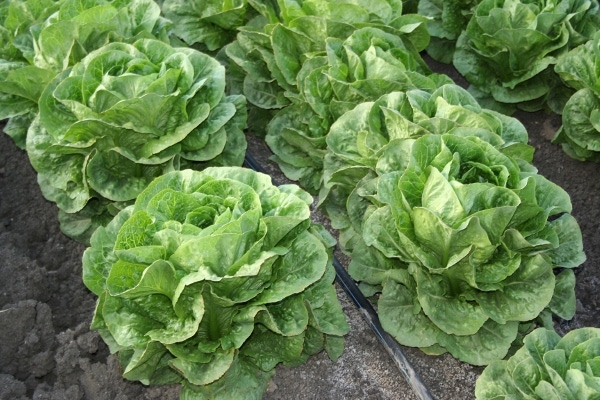
Updated best management practices for insect control in vegetables focus on shifting pest spectrums, selective pesticide technologies, resistance management, maximum residue levels, and other issues.For lettuce, the initial application of fungicides during the rosette stage, about 30 to 40 days before harvest, has been shown to significantly reduce the incidence of lettuce drop caused by airborne infections of Sclerotinia sclerotiorum.Most pre-emergent herbicides do not kill dormant weed seeds – in most cases the seeds must first germinate and contact the herbicide before the seeds are killed.
January 13, 2011

The latest Arizona Vegetable Integrated Pest Management Update from the University of Arizona (UA) Cooperative Extension in Yuma.
Best management practices for pest control in vegetables
By John Palumbo, UA Research Scientist and Extension Specialist
In 2008 a group of research and Extension vegetable entomologists and crop consultants from vegetable-producing states met to discuss pest management issues, plus challenges and opportunities confronting the fresh vegetable industry.
From that workshop, best management practice (BMP) recommendations were developed. A continuation of that meeting was held in 2009 and focused on refining the BMPs for vegetable insect control, and in general terms, defined a number of best practices for successful insect management in vegetable crops.
In addition, based on the cumulative experiences of the participating entomologists, the strengths and weaknesses of a number of new pesticide technologies (registered products and compounds under development) were identified. These included Radiant, Pyrifluquinazon, Oberon, Movento, Rimon, Coragen, Synapse, and Cyazypyr.
A number of important issues, challenges, and opportunities in insect control in vegetable crops were discussed based on regional perspectives. Among the topics discussed were shifting pest spectrums, trends toward selective pesticide technologies, resistance management, MRLs, and other production issues.
A copy of the 2009 BMPs generated from those discussions can be found at this link.
Contact Palumbo: (928) 928-782-3836 or [email protected].
Lettuce drop: aerial infection
By Mike Matheron, UA Extension Plant Pathologist
A widespread outbreak of aerial infections caused by the lettuce drop pathogen Sclerotinia sclerotiorum was reported in several locations in Yuma during the last week of December.
A review of the biology of the two lettuce drop pathogens and the environmental conditions required for production of airborne spores may help explain this occurrence.
Lettuce drop is caused by two fungal pathogens, Sclerotinia minor and Sclerotinia sclerotiorum. The pathogens produce structures called sclerotia which allow the organisms to survive in the soil between the plantings of host crops.
In desert plantings, infection of lettuce by S. minor and usually by S. sclerotiorum results from direct germination of sclerotia in the soil followed by the colonization of the base of the plants.
However, when soil moisture and temperature conditions are favorable, sclerotia ofS. sclerotiorum an inch or less below the soil surface can create fruiting bodies that in turn produce vast number of spores dispersed by wind throughout the field and to other fields. The spores germinate and cause aerial infections when deposited on lettuce leaf tissue.
The optimal conditions that stimulate airborne spore production include exposure of sclerotia to nearly saturated soil for at least a two-week period and soil temperatures ranging from approximately 52 to 60 degrees F. Soil in vegetable production fields is normally very wet and soil temperatures from Nov. 26 until the present have been in the favorable temperature range.
The airborne spores require free moisture from rainfall, dew, or sprinkler irrigation on senescent or damaged leaf tissue for optimal infection to occur. The weather record shows freezing temperatures throughout the area on Nov. 26 and 27 resulting in damaged lettuce leaf tissue, and rainfall on Dec. 21 and 22. The favorable conditions for airborne spore production and infection were present in the area.
In other agricultural regions where airborne infection of crops byS. sclerotiorum is common, foliar application of fungicides including Endura, Rovral, or Switch can provide significant disease protection.
For lettuce, the initial application of fungicides during the rosette stage, about 30 to 40 days before harvest, has been shown to significantly reduce the incidence of lettuce drop caused by airborne infections of Sclerotinia sclerotiorum.
Contact Matheron: (928) 726-6856 or [email protected].
Weed seeds and pre-emergent herbicides
By Barry Tickes, UA Area Agriculture Agent
Most pre-emergent herbicides do not kill dormant weed seeds. In most cases, the seeds must first germinate and contact the herbicide before they are killed. Some pre-emergent herbicides are absorbed only by the roots, some by shoots only (at the hypocotyl in broadleaves and at the coleoptile in grasses), and some by roots and shoots.
Weed seedlings sometimes emerge and grow for awhile before dying or becoming uncompetitive with the crop.
Some fumigants kill weed seeds including metam sodium (Vapam), clorpicrin (Telone), dazomet (Basamid), methyl bromide, methyl iodide, and calcium cyanamide.
Flooding and solarization also can kill weed seeds. Fumigants, flooding, and solarization are often used primarily to control diseases and have the added benefit of controlling some weeds.
Contact Tickes: (928) 580-9902 or [email protected].
You May Also Like



